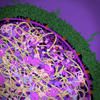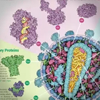 |
Since its discovery in 1928, penicillin and penicillin-related antibiotics helped save countless lives from bacterial infections. However, in the face of overuse and misuse of antibiotics, bacteria evolved resistance mechanisms that allow them to proliferate even in the presence of the newest antibiotics.
|
 |
After HIV enters a T-cell, three enzymes play essential roles in the life cycle of the virus. Reverse transcriptase copies the viral RNA genome and makes a DNA copy. Integrase inserts this viral DNA into the cell’s DNA. In the last steps of the viral life cycle, HIV protease cuts HIV proteins into their functional parts.
Current antiretroviral drugs target these three enzymes, hindering the virus reproduction. However, enzymes can mutate and become drug resistant, making it vital to use a combination of different drugs that target multiple enzymes.
This animation was created using many PDB entries for Reverse Transcriptase (3hvt, 3dlk, 3v6d, 3v4i, 3klg, 3v81), Integrase (3os1, 3os0, 3oya), Protease (3pj6, 1kj4, 1hxb, 2az9, 2azc), HIV Polyprotein (1l6n), Capsid Protein (2m8l), and Matrix Protein (1tam).
|
 |
This seminar was presented by Stephen K. Burley, MD, DPhil, and Shuchismita Dutta, PhD on December 5th 2014 as part of the World AIDS Day Symposium at the Rutgers Center for Integrative Proteomics Research in Piscataway, NJ.
|